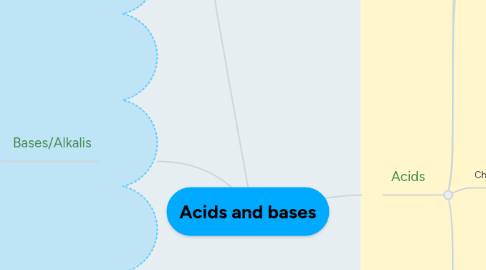
1. Acids
1.1. Definition
1.1.1. A substance that produces hydrogen ions in a queous solution
1.2. Physical Properties
1.2.1. has a sour taste
1.2.2. conducts electricity when dissolved in water
1.2.3. turns moist blue litmus paper red
1.3. Chemical properties
1.3.1. reacts with reactive metals to form a salt and hydrogen gas
1.3.1.1. metal+acid -> salt+hydrogen gas
1.3.1.2. eg: magnesium+dilute sulfuric acid -> magnesium sulfate+hydrogen
1.3.1.3. when non-reactive metals are used, no reaction to occur
1.3.1.3.1. eg: copper, silver
1.3.1.4. test for hydrogen gas: use a lighted splint. hydrogen gas extinguishes a lighted splint with a 'pop' sound
1.3.2. reacts with carbonates and hydrogen carbonates to form a salt, carbon dioxide and water
1.3.2.1. carbonate+acid -> salt+carbon dioxide+water
1.3.2.2. calcium carbonate+dilute nitric acid -> calcium nitrate+carbon dioxide+water
1.3.2.3. test for carbon dioxide: bubbling gas through limewater. Carbon dioxide forms a precipitate with limewater.
1.3.3. reacts with metal oxides and hydroxides to form a salt and water only
1.3.3.1. metal oxide+acid -> salt+water
1.3.3.2. zinc oxide+dilute sulfuric acid -> zinc sulfate+water
1.4. Uses of acids
1.4.1. hydrochloric acid -> removes impurities such as rust from metals
1.4.2. sulfuric acid -> 1. manufacture of detergents and fertilisers. 2. battery acid in cars.
1.4.3. Ethanoic acid -> Food preservative and flavour enhancer
2. Bases/Alkalis
2.1. Definition
2.1.1. A base is any metal oxide or metal hydroxide.
2.1.2. An alkali is a substance that produces hydroxide ions in aqueous solution
2.2. Physical Properties
2.2.1. has a bitter taste
2.2.2. turns moist red litmus paper blue
2.3. Chemical properties
2.3.1. react with acids to form a salt and water only
2.3.1.1. Acid + Base / Alkali -> Salt + Water
2.3.1.2. In a neutralisation reaction, the hydrogen ions from the acid and the hydroxide ions from the alkali react to form water
2.3.1.3. eg: sulfuric acid + potassium hydroxide -> potassium sulfate + water
2.3.2. alkalis, when heated with mmonium salts, give off ammonia gas
2.3.2.1. alkali + ammonium salt -> salt + water + ammonia
2.3.2.2. eg:sodium hydroxide + ammonium chloride -> sodium chloride + water + ammonia
2.3.2.3. test for ammonia gas: use moist red limus paper. ammonia gas turns moist red litmus paper blue
2.3.2.4. ammonia has a pungent smell
2.3.3. alkalis react with a solution of one metal salt to give another metal salt and metal hydroxide
2.3.3.1. Alkali (Metal A) + Metal Salt Solution (Metal B) -> Metal Salt (Metal A) + Metal Hydroxide (Metal B)
2.3.3.2. A precipitate is formed if the metal hydroxide is insoluble in water.
2.3.3.3. eg: sodium hydroxide + iron(II) chloride -> sodium chloride+iron(II) hydroxide
2.4. Uses of alkalis/bases
2.4.1. Sodium hydroxide ->Make soaps and detergents
2.4.2. Aqueous ammonia ->1. Make fertilisers 2. Used in window cleaners to remove grease from glass
2.4.3. Magnesium hydroxide ->1. Used in toothpaste to neutralise acids on our teeth 2. Used in antacids to relieve the pain of indigestion
2.4.4. Calcium oxide / hydroxide ->Neutralise excess acid in soil
3. The pH scale
3.1. The pH of a solution is a measure of the relative acidity, alkalinity or neutrality of the solution.
3.2. pH measures the concentration of hydrogen ions, H+, present in a solution.
3.3. It can be measured quantitatively using the Universal Indicator paper / solution or pH meter.
3.3.1. universal indicator: it comprises of a mixture of dyes
3.3.1.1. changes from green to red, orange or yellow when in acidic solutions
3.3.1.2. changes from green to blue, purple or violet when in alkaline solutions
3.3.2. pH meters / pH probes (attached to data loggers): it can be immersed in the solution to measure its pH and measures specific pH value up to 2 decimal places
3.4. The pH scale ranges from 0 to 14.
3.5. importance
3.5.1. Most plants grow well in neutral or slightly acidic soil of pH around 6.5
3.5.2. Soil may become too acidic due to the addition of excessive fertilisers or pollution from acid rain.
3.5.3. Excess acidity in soil can be neutralised by bases such as calcium hydroxide (slaked lime) or calcium oxide (quicklime).
3.6. Litmus papers
3.6.1. can be used to determine whether the solution is acidic, neutral or alkaline qualitatively based on the colour change.
3.6.2. It cannot provide information about the degree of acidity or alkalinity
